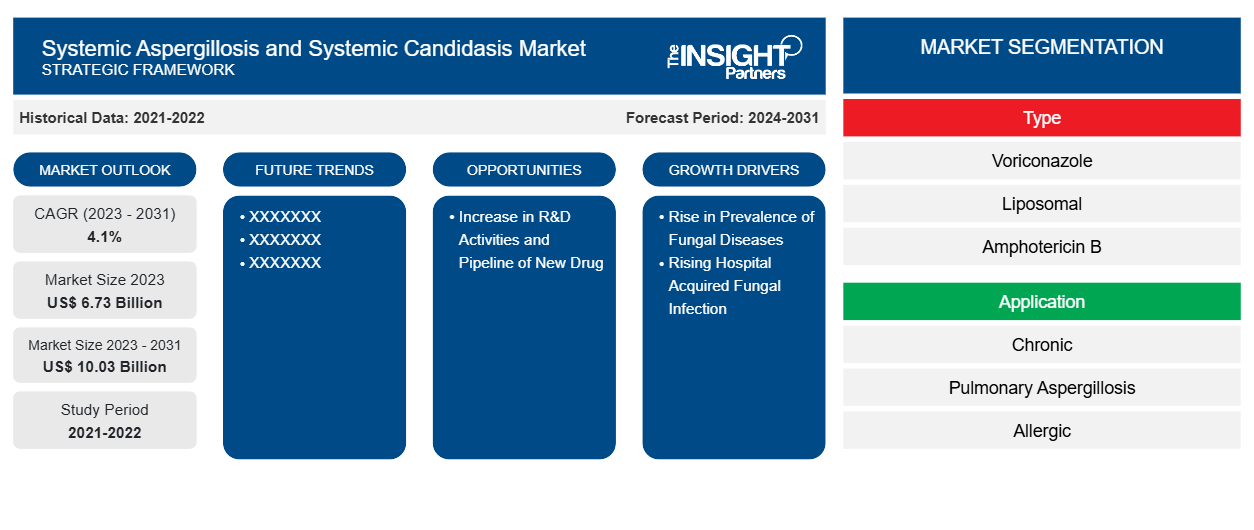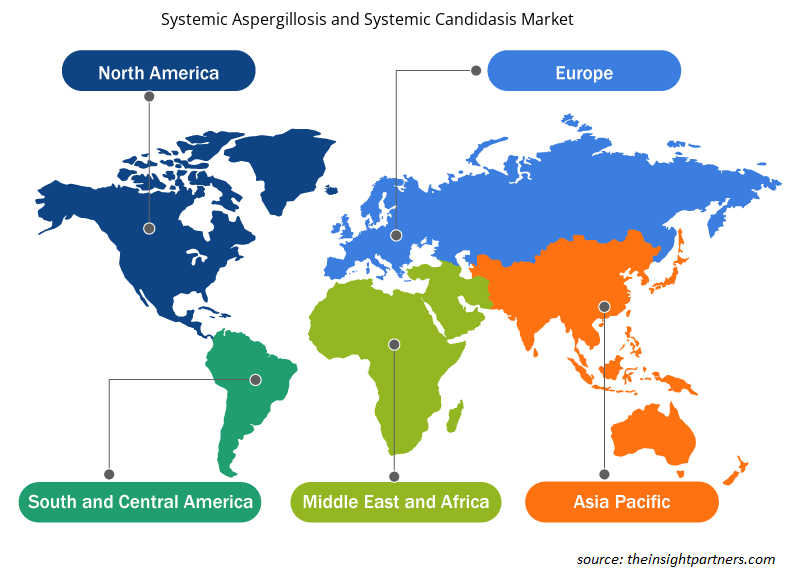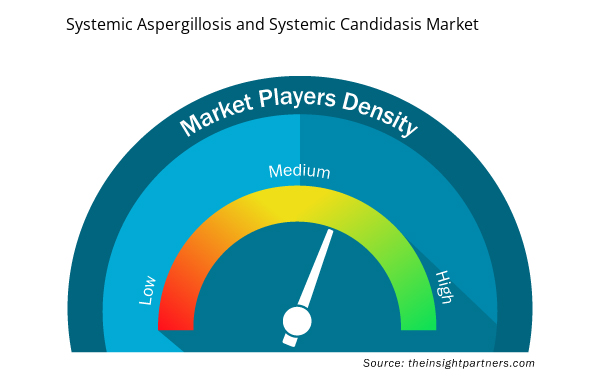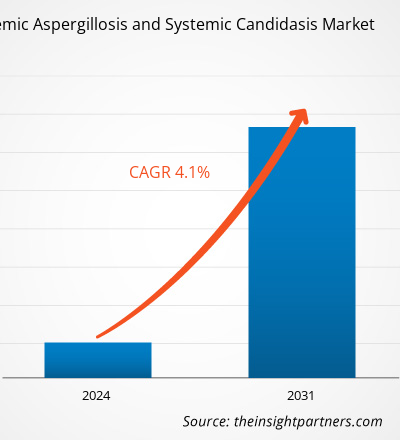The Systemic Aspergillosis and Systemic Candidasis Market size is projected to reach US$ 10.03 billion by 2031 from US$ 6.73 billion in 2023. The market is expected to register a CAGR of 4.1% in 2023–2031. Development of novel therapies for treatment of fungal diseases, rise in R&D activities for development of drugs, and increasing hospital acquired fungal diseases are likely to remain key Systemic Aspergillosis and Systemic Candidasis Market trends.
Systemic Aspergillosis and Systemic Candidasis Market Analysis
There is increase in prevalence of systemic aspergillosis and systemic candidiasis due to rising health problems. As the immune system gets weakened due to the HIV/AIDS pandemic, tuberculosis, chronic obstructive pulmonary disease (COPD), asthma, and the increasing incidence of cancers, the patient is more susceptible to fungal diseases. Thus, increase in prevalence of diseases that weaken the immune system is fueling the growth of the systemic aspergillosis and systemic candidiasis market.
Systemic Aspergillosis and Systemic Candidasis Market Overview
Fungal systemic infections are common in patients with weakened immune system, including immunosuppression and acquired immunodeficiency syndrome (AIDS) patients. Systemic signs consolidate apnea, guaiac-positive stools, abdominal distension, hyperglycemia, leukemoid reaction, hypotension, and others. The treatment of systemic candidiasis and aspergillos need parenteral antifungal therapy and this condition is associated with high mortality rate. Furthermore, this infection may result in permanent neurodevelopmental deficits in long-term survivors.
Customize This Report To Suit Your Requirement
You will get customization on any report - free of charge - including parts of this report, or country-level analysis, Excel Data pack, as well as avail great offers and discounts for start-ups & universities
Systemic Aspergillosis and Systemic Candidasis Market: Strategic Insights

- Get Top Key Market Trends of this report.This FREE sample will include data analysis, ranging from market trends to estimates and forecasts.
You will get customization on any report - free of charge - including parts of this report, or country-level analysis, Excel Data pack, as well as avail great offers and discounts for start-ups & universities
Systemic Aspergillosis and Systemic Candidasis Market: Strategic Insights

- Get Top Key Market Trends of this report.This FREE sample will include data analysis, ranging from market trends to estimates and forecasts.
Systemic Aspergillosis and Systemic Candidasis Market Drivers and Opportunities
Rising Hospital Acquired Fungal Infection to Favor Market
Candida Auris is a fungus that causes a serious global health threat. C. Auris causes severe illness in hospitalized patients in several countries, including the United States. Patients C. auris has caused outbreaks in healthcare facilities and can spread through contact with affected patients and contaminated surfaces or equipment. can remain colonized with C. Auris for a long time, and C. Auris can persist on surfaces in healthcare environments. This can result in the spread of C. Auris between patients in healthcare facilities. According to a CDC report of 2021, U.S. cases of C. Auris have been found in patients who had recent stays in healthcare facilities in Egypt, India, Kenya, Kuwait, Pakistan, South Africa, South Korea, the United Arab Emirates, and Venezuela, which also have documented cases.
Pipeline Analysis – An Opportunity in Customisation of Systemic Aspergillosis and Systemic Candidasis
The current landscape for systemic aspergillosis and systemic candidasis is promising, with multiple drug approvals, a rich pipeline, and many ongoing clinical trials. Pipelines of systemic aspergillosis and systemic candidasis are in various stages of clinical development; major pharmaceutical companies are working to advance the pipeline space and future growth potential of the systemic aspergillosis and systemic candidasis competitive domain. For instance, Ibrexafungerp Citrate, a drug for treatment of systemic candidiasis, is currently in phase III and is developed by Scynexis.
Systemic Aspergillosis and Systemic Candidasis Market Report Segmentation Analysis
Key segments that contributed to the derivation of the Systemic Aspergillosis and Systemic Candidasis Market analysis are type and application.
- Based on type, the Systemic Aspergillosis and Systemic Candidasis Market is divided into voriconazole, liposomal amphotericin b, systemic oral azoles, topical antifungal agents and others. The systemic oral azoles segment held the largest market share in 2023. Oral azole drugs such as fluconazole, ketoconazole, and itraconazole have a major advancement in systemic antifungal therapy. Among all the three, fluconazole has the most attractive pharmacologic (pharmacokinetics and pharmacodynamic) profile, including the capacity to produce high concentrations of active drug in cerebrospinal fluid and urine.
- By application, the market is segmented into chronic pulmonary aspergillosis (CPA), allergic bronchopulmonary aspergillosis (ABPA), gastrointestinal candidiasis, genitourinary tract, candidiasis, and others. The allergic bronchopulmonary aspergillosis (ABPA) segment held the largest share of the market in 2023.
Systemic Aspergillosis and Systemic Candidasis Market Share Analysis by Geography
The geographic scope of the Systemic Aspergillosis and Systemic Candidasis Market report is mainly divided into five regions: North America, Asia Pacific, Europe, Middle East & Africa, and South America/South & Central America.
North America has dominated the Systemic Aspergillosis and Systemic Candidasis Market. The growth of the region's market is attributed to the increasing incidences of fungal infections and growing product development and launches, and rising initiatives about fungal infections and their treatments. In addition, the growing health expenditures for the treatment of fungal infections are expected to drive the growth of the market during the forecast period to the dominance of the North America Systemic Aspergillosis and Systemic Candidasis Market. US is estimated to be the largest market for systemic aspergillosis and systemic candidasis. The growth is attributed to the increasing incidences of fungal infections that further encourage various pharmaceutical companies to invest in their R&D programs and introduce innovative treatment medicines in the market. For instance, in January 2020, Astellas Pharma Inc. announced it had received approval from FDA for its supplemental New Drug Application (sNDA) for MYCAMINE (micafungin for injection). Asia Pacific is anticipated to grow with the highest CAGR in the coming years.
Systemic Aspergillosis and Systemic Candidasis Market Regional Insights
The regional trends and factors influencing the Systemic Aspergillosis and Systemic Candidasis Market throughout the forecast period have been thoroughly explained by the analysts at Insight Partners. This section also discusses Systemic Aspergillosis and Systemic Candidasis Market segments and geography across North America, Europe, Asia Pacific, Middle East and Africa, and South and Central America.

- Get the Regional Specific Data for Systemic Aspergillosis and Systemic Candidasis Market
Systemic Aspergillosis and Systemic Candidasis Market Report Scope
| Report Attribute | Details |
|---|---|
| Market size in 2023 | US$ 6.73 Billion |
| Market Size by 2031 | US$ 10.03 Billion |
| Global CAGR (2023 - 2031) | 4.1% |
| Historical Data | 2021-2022 |
| Forecast period | 2024-2031 |
| Segments Covered |
By Type
|
| Regions and Countries Covered | North America
|
| Market leaders and key company profiles |
Systemic Aspergillosis and Systemic Candidasis Market Players Density: Understanding Its Impact on Business Dynamics
The Systemic Aspergillosis and Systemic Candidasis Market is growing rapidly, driven by increasing end-user demand due to factors such as evolving consumer preferences, technological advancements, and greater awareness of the product's benefits. As demand rises, businesses are expanding their offerings, innovating to meet consumer needs, and capitalizing on emerging trends, which further fuels market growth.
Market players density refers to the distribution of firms or companies operating within a particular market or industry. It indicates how many competitors (market players) are present in a given market space relative to its size or total market value.
Major Companies operating in the Systemic Aspergillosis and Systemic Candidasis Market are:
- Novartis AG
- Sanofi-Aventis
- Pfizer, Inc
- Merck and Co., Inc
- Enzon Pharmaceuticals, Inc
- Bayer AG
Disclaimer: The companies listed above are not ranked in any particular order.

- Get the Systemic Aspergillosis and Systemic Candidasis Market top key players overview
Systemic Aspergillosis and Systemic Candidasis Market News and Recent Developments
The Systemic Aspergillosis and Systemic Candidasis Market is evaluated by gathering qualitative and quantitative data post primary and secondary research, which includes important corporate publications, association data, and databases. The following is a list of developments in the market for systemic aspergillosis and systemic candidasis and strategies:
- Pfizer acquired Amplyx Pharmaceuticals, Inc. Pfizer has secured ownership of Amplyx's early-stage pipeline that includes potential antiviral (MAU868) and antifungal (APX2039) therapies. (Source: Pfizer, Press Release, 2021)
- Basilea Pharmaceutica Ltd has entered into an asset purchase agreement with Amplyx Pharmaceuticals, Inc., an affiliate of Pfizer Inc., acquired the rights to fosmanogepix, a clinical-stage broad-spectrum antifungal candidate. In addition, Basilea has acquired the rights to a preclinical antifungal compound. (Source: Biospace, Press Release, 2023)
Systemic Aspergillosis and Systemic Candidasis Market Report Coverage and Deliverables
The “Systemic Aspergillosis and Systemic Candidasis Market Size and Forecast (2021–2031)” report provides a detailed analysis of the market covering below areas:
- Market size and forecast at global, regional, and country levels for all the key market segments covered under the scope
- Market dynamics such as drivers, restraints, and key opportunities
- Key future trends
- Detailed PEST/Porter’s Five Forces and SWOT analysis
- Global and regional market analysis covering key market trends, major players, regulations, and recent market developments
- Industry landscape and competition analysis covering market concentration, heat map analysis, prominent players, and recent developments
- Detailed company profiles
- Historical Analysis (2 Years), Base Year, Forecast (7 Years) with CAGR
- PEST and SWOT Analysis
- Market Size Value / Volume - Global, Regional, Country
- Industry and Competitive Landscape
- Excel Dataset


- 3D Mapping and Modelling Market
- Europe Industrial Chillers Market
- Investor ESG Software Market
- Lymphedema Treatment Market
- Playout Solutions Market
- Artificial Intelligence in Defense Market
- Dried Blueberry Market
- Bioremediation Technology and Services Market
- Public Key Infrastructure Market
- Enteral Nutrition Market

Report Coverage
Revenue forecast, Company Analysis, Industry landscape, Growth factors, and Trends

Segment Covered
Type ; Application , and Geography

Regional Scope
North America, Europe, Asia Pacific, Middle East & Africa, South & Central America

Country Scope
Argentina, Australia, Brazil, Canada, China, France, Germany, India, Italy, Japan, Mexico, Saudi Arabia, South Africa, South Korea, Spain, United Arab Emirates, United Kingdom, United States

 Get Free Sample For
Get Free Sample For